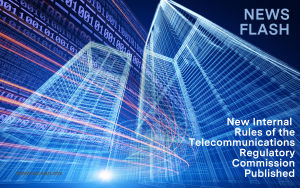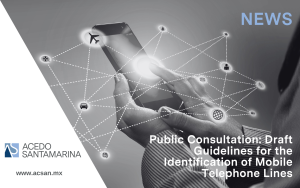On April 23, 2025, President-elect Claudia Sheinbaum submitted to the Senate of the Republic the draft decree issuing the Telecommunications and Broadcasting Law and repealing the Federal Telecommunications and Broadcasting Law (the “Decree Bill”).
The Decree Bill was subject to various criticisms, mainly due to: (i) the appointment of the Digital Transformation and Telecommunications Agency (the “Agency”), a body under the Federal Executive, as the new authority responsible for developing and implementing telecommunications and broadcasting policies; (ii) the excessive granting of 66 authorities to the Agency; (iii) the inclusion of Article 109, which would allow competent authorities to request the Agency’s collaboration for the temporary blocking of digital platforms; and (iv) the inclusion of Article 159 on security and justice obligations, which, although already provided for in the current Federal Telecommunications and Broadcasting Law (in Spanish, “LFTR”) published in the Official Gazette of the Federation (in Spanish, “DOF”) on July 14, 2014, stated that the Agency would have the authority to consult the mobile service user registry.
In response, the Political Coordination Board established dialogue tables involving various telecommunications service providers, accompanied by academics, advisors, and sector experts, with the aim of fostering debate and consensus regarding the legitimate concerns of citizens, as well as the technological and economic challenges that the approval of the Decree Bill would entail.
After the conclusion of the dialogue tables, the Senate made adjustments to the Decree Bill, resulting in the elimination of the aforementioned Article 109 on the temporary blocking of digital platforms, as well as the creation of the Telecommunications Regulatory Commission, among other changes.
Finally, on July 16, 2025, the DOF published the Decree issuing the Telecommunications and Broadcasting Law (the “Telecommunications Law”), which repeals the LFTR and substantially modifies the regulatory framework that had governed the telecommunications and broadcasting sectors in Mexico for more than a decade.
The Telecommunications Law originates as part of the Organic Simplification Reform, published in the DOF on December 20, 2024 (the “Reform”), which dissolved various constitutionally autonomous bodies, including the Federal Telecommunications Institute (in Spanish, “IFT”) and the Federal Economic Competition Commission (in Spanish, “COFECE”).
The Telecommunications Law published in the DOF requires a dedicated analysis to understand the main changes introduced. In this regard, and without intending to be exhaustive here, the main changes established in the Telecommunications Law are described below:
Structural Changes Regarding the Regulatory Body
The main structural changes introduced by the Telecommunications Law include the creation of the Telecommunications Regulatory Commission (the “Commission”), an administrative body decentralized from the Agency, as the new regulatory authority for the telecommunications and broadcasting sectors.
The Commission has a structure entirely different from its predecessor, the IFT, which was a constitutionally autonomous body, independent in its decisions and operations, with its own legal personality and patrimony.
Under the new institutional design set forth in the Telecommunications Law, the functions previously concentrated in the IFT are now divided between two distinct bodies: the Agency, responsible for the design and implementation of public policy, and the Commission, responsible for technical regulation, operational oversight, and imposition of sanctions.
By way of further explanation, the Agency is now tasked with formulating national policies on telecommunications, broadcasting, and satellite services, as well as planning and executing connectivity programs, social coverage, and broadband access in public sites. It also assumes the administration of the State’s satellite capacity and intergovernmental coordination for the streamlining of procedures related to infrastructure.
In turn, the Commission concentrates the most relevant technical functions: granting and amending concessions and authorizations, administering the radio spectrum, regulating interconnection and interoperability conditions, monitoring service quality, imposing sanctions, and resolving disputes between concessionaires. It also maintains powers related to the protection of audience rights, content oversight, tariff regulation, and access to multiprogramming.
Appointment of Commissioners
The Commission will be composed of five (5) Commissioners, instead of seven (7) as in the IFT, including the Chairman, who will be appointed in a staggered manner directly by the Head of the Executive and ratified by a majority of the Senate.
As to the appointment of Commissioners, President Claudia Sheinbaum indicated that she will present the list of candidates for the position of Commissioner at the commencement of the legislative session, namely on September 1. The Senate will have thirty (30) calendar days to ratify these appointments by simple majority. Subsequently, the President will have ten (10) days to designate, from among the ratified candidates, the Chairman of the Commission.
According to the transitional provisions, the Telecommunications Law entered into force on July 17, 2025. However, until the Plenary of the Commission is integrated, the IFT will continue to operate; the day after the Plenary is formed, the LFTR will be officially repealed, and the IFT will be formally dissolved. In this regard, considering the timelines for the Senate to ratify the proposed Commissioners and for the President to appoint the Chairman, the Commission is expected to be officially integrated by late September or early October of this year.
Timelines for the Entry into Force of the Telecommunications Law
Although the Commission is expected to begin operations in the weeks following its integration, questions remain regarding the functioning and operational capacity of the IFT until that time. This concern arises from the fact that, at the end of 2024, the IFT suffered a budget cut of more than seventy percent (70%) compared to the amount requested for the 2025 fiscal year. Furthermore, according to the transitional provisions of the Telecommunications Law, the IFT’s financial resources must be allocated to severance and final settlement payments, as applicable. Consequently, questions arise as to the resources available for the IFT to maintain operational continuity until the Commission’s Plenary is integrated and the Chairman appointed.
Finally, upon the integration of the Commission’s Plenary, all administrative procedures and processes will be suspended for fifteen (15) business days, except for the fulfillment of obligations by concessionaires, authorized entities, permit holders, and economic agents in the telecommunications and broadcasting sectors, as well as other regulated parties, who must continue to comply with the law regardless of the authority’s transition.
The deadlines established in Chapter 3, Section 3.3, of the 2025 Annual Program for the Use and Exploitation of Frequency Bands, published in the DOF on February 6, 2025, will also remain in effect. The process for requesting Equipment Homologation Certificates will be subject to a suspension of five (5) business days.
Expansion of Regulated Subjects
The Telecommunications Law includes digital platforms as a new regulated subject and defines “digital platform” as: the digital service provided by intermediaries through the Internet in order to, among other things, offer, provide, market, or intermediate goods, services, applications, products, or content.
In this regard, the Telecommunications Law provides that digital platforms whose content is available within the national territory may not commercialize advertising space for the dissemination of advertising, propaganda, or any information originating from foreign governments, except for that intended for cultural, tourism, or sports purposes. Failure to comply with this provision may result in fines ranging from two percent (2%) to five percent (5%) of the digital platform’s revenues.
Obligations in Security and Justice Matters
One of the main criticisms of the Telecommunications Law is that it still does not define the concept of “application and content services” used in the chapter on Cooperation with Justice, maintaining a concept as broad as that defined by the competent authority itself.
It could be assumed that, in due course, the authority might attempt to use the definition of “digital platform” to define “application and content services.” This is concerning, as most applications currently require the use of geolocation either for their operation or to enhance user experience, which broadens the range of possibilities for a digital platform to be required by authorities to cooperate with justice — from audio, video, products, services, and content applications to financial, e-commerce, or transportation platforms.
Furthermore, the Telecommunications Law extends to all types of concessionaires and authorized entities that use any type of terminal the obligations to maintain control and records of communications, provide retained data when so requested by competent authorities, and collaborate with security, law enforcement, and judicial authorities in the real-time geographic location of terminal equipment.
Although the LFTR already contemplated this obligation, the wording of the relevant articles was understood to apply only to concessionaires and authorized entities providing mobile services. Therefore, it is expected that the guidelines and/or regulations issued by the Commission will clarify existing doubts on the matter.
Participation of State-Owned Companies
The Telecommunications Law allows the Federal Electricity Commission (in Spanish, “CFE”), as a state-owned productive company, to obtain single commercial-use concessions and participate in radio spectrum auctions, provided that it complies with applicable legal requirements and adheres to the principle of competitive neutrality. Furthermore, it must share its infrastructure in accordance with the guidelines issued by the Commission.
Beyond what the Telecommunications Law formally provides, there are well-founded doubts as to whether a level playing field will truly exist between CFE and private concessionaires. One of the sector’s main concerns is whether CFE, as a public company, will be subject to the same economic burdens, particularly regarding payment for the use of radio spectrum — one of the most onerous obligations for commercial operators. Although the legal framework refers to competitive neutrality, close attention will need to be paid to its practical implementation, as any preferential treatment — direct or indirect — could distort the market and significantly impact free competition and private investment in the sector.
New Obligations for Public Network Concessionaires
The new Telecommunications Law imposes new requirements on concessionaires, including:
- Concessionaires and, where applicable, authorized entities must deliver, either directly or through third parties, unlocked mobile terminal equipment for both prepaid and postpaid services.
- Provide end users free access to alert services and platforms of public bodies, as determined by the Commission.
- Avoid exclusivity agreements that limit users’ ability to acquire terminal equipment.
- Refrain from entering into exclusive contracts that prevent other concessionaires from accessing distribution channels or points of sale for mobile services such as airtime.
The Telecommunications Law also expressly establishes that concessionaires must guarantee free calls to emergency numbers and government service lines.
Changes to the Authorization Regime
New circumstances requiring authorization from the Commission for the use of radio spectrum are introduced, including:
- The use of spectrum bands for experimentation, technical and economic validation of developing technologies, or temporary testing of equipment.
- The use of non-concessioned spectrum bands to meet the needs of intelligent radiocommunication networks.
In addition, the Telecommunications Law now expressly establishes that authorization will be required for the secondary use of spectrum bands for specific events or in facilities intended for commercial or industrial activities.
Mandatory User Identification
The new Telecommunications Law provides that concessionaires operating public telecommunications networks with mobile service may only activate and must maintain active those lines linked to end users who have provided an official identification. For individuals, this must include their Unique Population Registry Code (in Spanish, CURP); for legal entities, their Federal Taxpayer Registry (in Spanish, RFC); and for foreign individuals, full name, country of origin, and passport number.
The transitional provisions of the Telecommunications Law establish that, within no more than one hundred twenty (120) business days from its entry into force, the Commission must issue guidelines setting out how this identification process should be carried out.
This new requirement has raised concerns among sector specialists, as it recalls the failed National Registry of Mobile Telephony Users (in Spanish, “PANAUT”), established in 2021 and subsequently declared unconstitutional by the Supreme Court of Justice of the Nation. On that occasion, the Court concluded that PANAUT violated privacy and personal data protection rights by requiring biometric data without proportional justification or adequate safeguards. It also determined that the State lacked the institutional and technological capacity to adequately protect such sensitive information.
Although the Telecommunications Law no longer requires biometric data, as the LFTR did for the implementation of PANAUT, it again imposes a generalized identification obligation without clarity on how the data will be protected, what specific obligations concessionaires will have as data controllers, or how compliance will be verified without infringing fundamental rights. This has reignited debate over whether a surveillance model previously rejected for constitutional reasons is being reintroduced now with a different legal basis but potentially similar effects.
Consequently, it will be crucial to monitor the content of the guidelines issued by the Commission and their compatibility with the principles of personal data protection, proportionality, and minimal intervention.
Expansion of the Catalogue of User Rights
Telecommunications Law recognizes new rights for telecommunications service users, such as:
- Purchasing airtime recharge from any provider.
- Receiving at least thirty (30) days’ advance notice of contractual modifications, retaining the option to demand compliance with the original term or revoke their consent.
- Obtaining unlocked equipment in prepaid and postpaid services.
- Making free calls to citizen service numbers.
- Providing express authorization for any additional charge not included in the originally contracted service.
Radio Spectrum Allocation
The Telecommunications Law provides that all permits, concessions, and titles related to the use of radio spectrum granted before the LFTR must be adapted to the new regime — either through a concession, authorization, or registration certificate — within a maximum period of one year from the Law’s entry into force. Failure to do so will result in the termination of these titles before the Commission.
The Commission will also have the power to conduct tests in any available radio spectrum band for radiocommunication services, either on its own or in collaboration with operators and equipment manufacturers.
Additionally, the new Telecommunications Law establishes that concessionaires may obtain reductions in spectrum usage fees if they commit to providing connectivity in low-coverage areas. While this measure is presented as a positive incentive, it does not represent the structural change expected, as Mexico continues to have some of the highest spectrum prices in Latin America, which has historically hindered investment and network expansion.
Although recognizing this issue is a step forward, the wording of the Telecommunications Law leaves many questions about how the discount scheme will operate. In practice, it may create uncertainty for operators, especially smaller ones, and makes it difficult to determine whether there will be any significant financial relief. The sector expected a clearer, more structured, and transparent review of the spectrum pricing model, which did not fully materialize in the Law.
5G Auction
The Telecommunications Law resumes the deployment of fifth-generation mobile networks (“5G”). In late 2024, the IFT published the Call for Bids IFT-12, under which it planned to award more than two thousand spectrum blocks, including key bands such as 600 MHz, essential for expanding 5G coverage in the country. This auction was seen as the natural step in the sector’s technological evolution after several years without relevant spectrum allocation processes.
However, the auction was canceled in January 2025, after the Federal Government — through the Agency — questioned its legitimacy, alleging that it was a hasty action by the IFT prior to its dissolution, and arguing that there were no clear institutional or legal conditions to conduct such a process during a regulatory transition. As a result, the IFT Plenary agreed to follow the instruction and formally suspended the auction on January 15, 2025, creating a vacuum regarding the future use of spectrum for advanced mobile services.
Despite the cancellation, the transitional provisions of the new Telecommunications Law resume this auction. In particular, they establish that, within the first one hundred eighty (180) calendar days after the entry into force of the Telecommunications Law, the Commission must publish a new bidding plan to allocate spectrum for mobile wireless access service. This mandate directly aims to reactivate the process, albeit under a new institutional design and in accordance with the criteria set by the newly created regulatory authority.
What happens in the coming months will be critical for the development of the 5G ecosystem in Mexico. The way in which the Commission designs the bidding terms, participation requirements, economic considerations, and technical and regulatory conditions will determine not only the success of technological deployment but also the level of certainty and confidence that operators and investors place in the new regulatory authority.
Interconnected Networks
Contrary to what was established in the LFTR, the Telecommunications Law provides that concessionaires with already interconnected networks, whose agreements have expired, must adhere to the terms, conditions, and rates determined by the Commission and in force at the time the new agreement is signed.
In case of disagreements between concessionaires, these may only relate to aspects not previously defined by the Commission, thus limiting the scope for disputes.
Likewise, public and social-use concessionaires will have the possibility of requesting interconnection with commercial networks, under the terms established by the Agency.
Antitrust Matters
The Commission will no longer have exclusive authorities in antitrust matters in the telecommunications and broadcasting sectors — authorities that, to date, belonged to the IFT. This jurisdiction will now fall to the National Antitrust Commission (in Spanish, “CNA”), the body that will replace COFECE. Proceedings initiated by the IFT in antitrust matters will continue before the CNA.
Implications for the USMCA
The Telecommunications Law represents a structural shift in Mexico’s regulatory model and poses serious implications with respect to Mexico’s commitments under the United States-Mexico-Canada Agreement (“USMCA”).
The USMCA requires each country to ensure the existence of a telecommunications regulatory body that is functionally separate and free from any undue influence, including that of service providers, as well as from the political or economic interests of the government in power. This institutional independence is a binding obligation aimed at ensuring effective competition, legal certainty, and fairness for all market operators, including foreign ones.
It should be noted that, in the United States, the sector regulator – the Federal Communications Commission (FCC) – is a federal government agency which, although part of the Executive and overseen by Congress, operates with technical and operational autonomy. From this perspective, it could be argued that the new Mexican model seeks to align with a similar framework; however, in Mexico’s case, there is greater concern over possible political interference, given the institutional conditions and the context of centralized decision-making.
Therefore, while the existence of a constitutionally autonomous body is not an explicit requirement under the USMCA, what matters is that the regulator has effective guarantees of independence, which remains to be demonstrated under the new framework. Otherwise, Mexico could face challenges under the treaty, including potential investment disputes that could negatively affect the telecommunications sector and the confidence of foreign operators.
Elimination of Reserved Spectrum
Another change in the Telecommunications Law is the elimination of the “reserved spectrum” category previously provided for in the LFTR. Under that regime, reserved spectrum encompassed bands under planning, different from determined, free, or protected spectrum, allowing the regulator to temporarily exclude certain frequencies from the market for strategic purposes, technical reorganization, or future policies.
In contrast, the new Telecommunications Law no longer contemplates this classification, meaning that radio spectrum can now only be allocated through the mechanisms provided for in the law, such as concession, authorization, registration certificate, or free use, in accordance with the Commission’s determinations. This change implies a shift in spectrum management policy by eliminating a category that previously allowed the holding of bands pending future allocation.
Going forward, it will be important to observe how bands previously classified as reserved or under planning will be managed, as well as the technical and administrative criteria the Commission will adopt to justify allocation, operational reservation, or spectrum reorganization, particularly in sectors such as security, civil protection, or official State services.
Small Telecommunications Operator
The new Telecommunications Law expressly recognizes the figure of the small operator, defined as a concessionaire or authorized entity providing telecommunications services for social or commercial use, with local or regional coverage, and meeting the criteria defined by the Commission. This recognition is an advance compared to the previous framework, where there was no differentiated category and many small-scale operators faced disproportionate regulatory burdens compared to large concessionaires.
With this definition, it can be anticipated that small operators may gain access to differentiated regulatory conditions, including reductions or exemptions in spectrum usage fees, as well as more flexible rules regarding coverage, infrastructure sharing, and administrative obligations. However, the effectiveness of this scheme will depend on the Commission promptly and clearly defining the technical and operational criteria for classifying an operator as small, which has not yet occurred. Until then, uncertainty remains about the implications and potential benefits of this change.
Final Remarks
While it is still necessary to wait for the Commission to issue secondary legislation regulating the telecommunications and broadcasting sectors, a preliminary analysis of the new Telecommunications Law reveals a series of regulatory tensions. On one hand, provisions are introduced that could strengthen certain aspects of user protection; on the other, mechanisms previously declared unconstitutional — such as the mandatory registration of mobile telephony users — are reinstated, raising serious concerns regarding privacy and personal data protection.
The disappearance of the IFT as an autonomous body also marks a turning point in guaranteeing regulatory independence, especially in light of Mexico’s international commitments. While it could be argued that the new institutional design aligns with international models such as that of the United States, Mexico’s political and institutional conditions make it necessary to closely monitor the implementation of this framework.
In this context, it is essential for telecommunications and broadcasting service providers, together with their legal teams and external advisors, to anticipate compliance with the new regulatory framework to mitigate the risk of sanctions or fines that could compromise operations or even result in the loss of enabling titles to provide telecommunications services.
At Acedo Santamarina, S.C., we remain at your disposal to provide advice on the scope and implications of the Telecommunications Law. For such purpose, you may contact the following individuals through the details below:
Andrés Acedo Moreno
Email: aacedo@acsan.mx
Phone: 5543541253
José Luis Mejía Estrada
Email: jlmejia@acsan.mx
Phone: 7221085400
Enrique López Mandujano
Email: emandujano@acsan.mx
Phone: 5573267739





